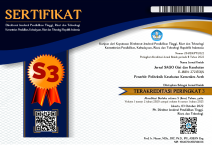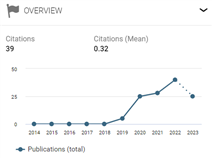Tingkat pengetahuan tentang bantuan hidup dasar (BHD) pada pengemudi kendaraan umum Kota Medan: Studi kuasi-eksperimental
DOI: 10.30867/gikes.v6i2.2643Abstract
Background: Basic Life Support (BLS) knowledge is essential, particularly for public transport drivers who frequently encounter medical emergencies. Adequate education on BLS can enhance their preparedness in responding to such situations.
Objectives: This study aims to assess the level of knowledge among public transport drivers in Medan City regarding BLS before and after an educational intervention
Methods: This study employed a quasi-experimental design using a one-group pretest-posttest approach. The sample consisted of 521 public transportation drivers in Medan City, divided into four groups: angkot drivers (125), online motorcycle taxi drivers (201), motorized rickshaw drivers (125), and rental car drivers (50). Data were collected using a structured questionnaire containing items assessing basic knowledge of Basic Life Support (BLS), administered both before and after an educational intervention. Data were analyzed descriptively to summarize respondent characteristics, and paired t-tests and Chi-Square tests were used to assess statistical differences in knowledge scores before and after the intervention and between driver groups.
Results: The majority of participants were male (n = 451, 86.56%), with the most common age range being 31–40 years (n = 250, 47.98%). Most respondents had completed junior high school (n = 251, 47.98%), and the largest driver category was online motorcycle taxi drivers (n = 201, 38.57%). The initial assessment indicated that most participants had a limited understanding of BLS. However, post-intervention analysis demonstrated a statistically significant improvement, with the majority achieving higher knowledge scores in the posttest.
Conclusion: Educational interventions on Basic Life Support significantly enhance the knowledge levels of public transport drivers in Medan City, as evidenced by the substantial difference between pretest and posttest scores.
Keywords
Full Text:
PDFReferences
Birkun, A., Gautam, A., & Trunkwala, F. (2021). Global prevalence of cardiopulmonary resuscitation training among the general public: A scoping review. Clinical and Experimental Emergency Medicine, 8(4), 255.
Cheng, A., Macias, L., Dunn, A., et al. (2020). Part 6: Resuscitation education science: 2020 american heart association guidelines for cardiopulmonary resuscitation and emergency cardiovascular care. Circulation, 142(16 Suppl 2), S551–S579.
Greif, R., Lockey, A. S., Conaghan, P., et al. (2021). European Resuscitation Council Guidelines 2021: Education for resuscitation. Resuscitation, 161, 388–407.
Howard, G., Kissela, B., Sharma, R., et al. (2023). Age-related differences in the role of risk factors for ischemic stroke. Neurology, 100(14), e1444–e1453.
Kementerian Kesehatan Republik Indonesia. (2018). Laporan Riskesdas 2018. Jakarta: Kementerian Kesehatan Republik Indonesia.
Martin, S. S., Bittencourt, M. S., Virani, S. S., et al. (2024). 2024 heart disease and stroke statistics: A report of US and global data from the American Heart Association. Circulation, 149(8), e347–e913. https://doi.org/10.1161/CIR.0000000000001209
Olasveengen, T. M., Deasy, C., Semeraro, F., et al. (2021). European Resuscitation Council Guidelines 2021: Basic life support. Resuscitation, 161, 98–114.
Panchal, A. R., Bartos, J. A., Cabañas, J. G., et al. (2020). Part 3: Adult Basic and Advanced Life Support: 2020 American Heart Association Guidelines for Cardiopulmonary Resuscitation and Emergency Cardiovascular Care. Circulation, 142(16 Suppl 2), S366–S468.
Pereira, V., Iqbal, S., & Desai, N. (2024). The art of gamifying digital gig workers: A theoretical assessment of evaluating engagement and motivation. Production Planning & Control, 35(13), 1608–1624.
Razzak, J., Luby, S., Thabet, F., et al. (2022). Improvement in trauma care for road traffic injuries: An assessment of the effect on mortality in low-income and middle-income countries. The Lancet, 400(10348), 329–336.
Rosida, N. A., Saputro, S. D., & Rahmad, M. N. (2023). Simulation of Basic Life Support (BLS) training in improving self-efficacy of cardiac arrest first aid in adolescents. Jurnal Kreativitas PKM, 6(11), 4437–4448.
Scapigliati, A., Cortellaro, F., Bianchi, S., et al. (2021). Community initiatives to promote basic life support implementation—a scoping review. Journal of Clinical Medicine, 10(24), 5719.
Ssewante, N., Walakira, E., Nansubuga, F., et al. (2022). Assessment of knowledge, attitude and practice of first aid among taxi operators in Kampala City Taxi Park, Uganda: A cross-sectional study. African Journal of Emergency Medicine, 12(1), 61–66.
Suverein, M. M., Deneux-Tharaux, C., Chatelle, C., et al. (2023). Early extracorporeal CPR for refractory out-of-hospital cardiac arrest. New England Journal of Medicine, 388(4), 299–309.
Tsao, C. W., Aday, A. W., Almarzooq, Z. I., et al. (2023). Heart disease and stroke statistics—2023 update: A report from the American Heart Association. Circulation, 147(8), e93–e621. https://doi.org/10.1161/CIR.0000000000001123
Weile, J., Olesen, J., & Hansen, K. (2021). Simulation-based team training in time-critical clinical presentations in emergency medicine and critical care: A review of the literature. Advances in Simulation, 6, Article 1–12.
Yan, S., Xu, Y., Chen, R., et al. (2020). The global survival rate among adult out-of-hospital cardiac arrest patients who received cardiopulmonary resuscitation: A systematic review and meta-analysis. Critical Care, 24, Article 1–13.
Refbacks
- There are currently no refbacks.













